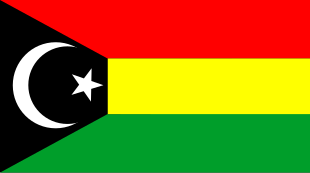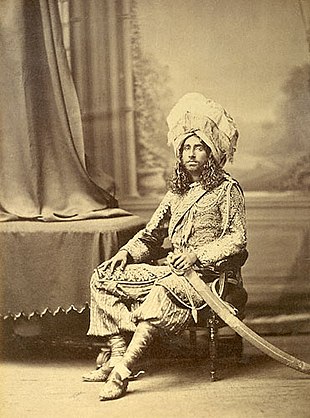Bahawalpur (State)
| Bahawalpur | |||||
| 1802-1955 | |||||
|
|||||
| Capital | Bahawalpur | ||||
| Form of government | Princely State (17 rounds salute) | ||||
| surface | 45,911 km² | ||||
| population | 1,341,209 (1941) | ||||
| founding | 1802 | ||||
| resolution | October 14, 1955 | ||||
| State religion: Islam. Dynasty: Abbasi |
|||||
| Location of Bahawalpur within Pakistan | |||||
| Flag of Bahawalpur (1945–1955) | |||||
| Nawab Muhammad Bahawal Khan Abbasi V. Bahadur of Bahawalpur | |||||
Bahawalpur ( Punjabi : بہاولپور) was a Muslim princely state in the south of Punjab in what is now Pakistan . It was founded in 1690 by Bahadur Khan II Abbasi and gained its independence at the beginning of the 19th century. In 1833 he became dependent on Great Britain . He joined Pakistan in 1947, but the final dissolution and integration into the province of West Pakistan did not take place until 1955.
history
The region was initially called Shikarpur after the capital founded in 1690 and was under the northern Indian Mughal Empire . The members of the Daudputra tribe trace their descent to the Prophet's uncle, al-ʿAbbās ibn ʿAbd al-Muttalib , and therefore call themselves Abbasids . Sultan Ahmad II (son of Shah Muzammil of Egypt) left his country and arrived in Sindh around 1370 with a large following of Arabs. He married the daughter of Raja Rai Dhorang Sahta and receives a third of the land as a dowry. Emir Fathu'llah Khan Abbasi is the recognized ancestor of the dynasty. He conquered the Bhangar territory from the Raja Dallu of Alor and Bhamanabad and renamed it Qahir Bela. Emir Muhammad Chani Khan Abbasi enters imperial service and is appointed Panchhari in 1583 . After his death, the leadership of the tribe is shared between 2 lines of the family (the Daudputra and the Kalhora). Emir Bahadur Khan II. Abbasi leaves Tarai and settles near Bhakkar and founded Shikarpur in 1690. They were expelled from their traditional settlement areas near Rori-Bhakar ( Sindh ) to Bahawalpur in 1737 when Daud Khan (the first of his family to rule the Bahawalpur) got into a dispute with the Afghan governor of Sindh appointed by Nadir Shah and had to flee.
Sadiq Muhammad Khan I submitted to the Persian conqueror Nadir Shah in 1739 , for which he received the hereditary title Nawab a year later (pays homage to him in Dera Ismail Khan where the Shah gives him the hereditary title Nawab on January 5, 1740 ). Nadir Shah was assassinated in 1747. As a result, the state came under the influence of the Afghan Durrani dynasty.
For the next few years, the heads of each clan ruled independently in their respective areas. Daud Muhammad Bahawal Khan I , a grandson of Daud, managed to unite the tribe. In 1748 he founded Bahawalpur as the new capital and from then on called himself Nawab von Bahawalpur. His son Mubarik then managed to get an area south of the former river course of the Beas (adds Pakpattan, Mailsi, Dunyapur and Kahror to his rule).
In 1780 Muhammad Bahawal Khan II received the honorary titles Rukn ud-Daula ("Pillar of the State"), Hafiz ul-Mulk ("Guardian of the Kingdom"), Nusrat Jung ("Victorious in the Battle") and Nawab Bahadur from the Mughal Mughal Shah Alam II. The territory was briefly occupied in 1789 by the troops of the Afghan Timur Shah . In 1802 he was given the title Mukhlis ud-Daula ("Devoted servant of the state") from the Afghan ruler Mahmud Shah Durrani and had his own coins minted for the first time as a sign of his sovereignty.
Bahawalpur escaped submission by the Sikh empire under Ranjit Singh , which expanded rapidly at the beginning of the 19th century , through a protection treaty with the British East India Company on February 22, 1833. Although the British confirmed the independence of Bahawalpur in another treaty of 1835, it did As a result, the state actually sank to a vassal of the East India Company or, from 1858, British India . Bahawalpur issued its own postage stamps between 1945 and 1949.
On October 7, 1947, the last ruling Nawab of Bahawalpur declared his country's accession to the newly founded state of Pakistan, but still ruled until Bahawalpur was incorporated into the province of West Pakistan on October 14, 1955. The former state territory of Bahawalpur is now divided into the districts of Bahawalpur , Bahawalnagar and Rahimyar Khan of the Punjab Province, founded in 1970 .
Ruler of Bahawalpur
The rulers of Bahawalpur were Abbasids who came from Shikarpur and Sukkur and conquered the areas of what later became Bahawalpur. They carried the title Amir (i.e. Emir ) until 1740, when the title was changed to Nawab Amir . Although this title was abolished in 1955 by the government of Pakistan, the current head of Bahawalpur (Salah ud-Din Muhammad Khan) is called an emir. From 1942 the nawab was supported by a prime minister.
| Term of office | Nawab Amir from Bahawalpur |
|---|---|
| 1690-1702 | Amir Bahadur Khan II. Abbasi, Emir of Shikarpur |
| 1702-1723 | Amir Muhammad Mubarak Khan I. Abbasi, Emir of Shikarpur |
| 1723-11. April 1746 | Nawab Amir Sadiq Muhammad Khan I Abbasi, Emir of Shahr Dand, 1st Navab of Bahawalpur (January 5, 1740) |
| April 11, 1746-12. June 1750 | Nawab Amir Muhammad Bahawal Khan I. Abbasi, 2nd Navab of Bahawalpur |
| June 12, 1750-4. June 1772 | Nawab Amir Muhammad Mubarak Khan II Abbasi, 3rd Navab of Bahawalpur |
| June 4, 1772-13. August 1809 | Nawab Amir Muhammad Bahawal Khan II Abbasi, 4th Navab of Bahawalpur |
| August 13, 1809-17. April 1826 | Nawab Amir Sadiq Muhammad Khan II Abbasi, 5th Navab of Bahawalpur |
| April 17, 1826-19. October 1852 | Nawab Amir Muhammad Bahawal Khan III. Abbasi, 6th Navab from Bahawalpur |
| October 19, 1852-20. February 1853 | Nawab Amir Sadiq Muhammad Khan III. Abbasi, 7th Navab from Bahawalpur |
| February 20, 1853-3. October 1858 | Nawab Amir Fateh Muhammad Khan Abbasi, 8th Navab from Bahawalpur |
| October 3, 1858-25. March 1866 | Nawab Amir Muhammad Bahawal Khan VI. Abbasi, 9th Navab from Bahawalpur |
| March 25, 1866-14. February 1899 | Nawab Amir Sadiq Muhammad Khan III. Abbasi, 10th Navab from Bahawalpur |
| February 14, 1899-15. February 1907 | Nawab Amir Muhammad Bahawal Khan V. Abbasi, 11th Navab of Bahawalpur |
| February 15, 1907-14. October 1955 | Nawab Amir Sadiq Muhammad Khan IV. Abbasi, 12th Navab of Bahawalpur |
Family tree of the dynasty
Bahadur Khan II. Abbasi (son of Firuz Khan Abbasi, founded Shikarpur in 1690, Emir of Shikarpur 1690–1702 [† 1702])
- Muhammad Mubarak Khan I. Abbasi (only son and successor, Emir of Shikarpur 1702–1723, abdicated in 1723 in favor of the son, † August 1723 in Shikarpur)
- Sadiq Muhammad Khan I. Abbasi (son and 1723 successor of the previous one, Emir of Shahr Daud, pays homage to Nadir Shah of Persia, who on January 5, 1740 gives him the hereditary title of Nawab , 1st Nawab of Bahawalpur, killed in the siege of Shikarpur on April 11, 1746, 3 sons)
Muhammed Sadiq Khan (governor under Sikh suzerainty), his descendants (* = main heir) :
- 1st generation
- Mian Fatah Muhammed Khan ( Nawabzada Fateh Muhammad Khan)
- Nawab Muhammad Bahawal Khan I. Abbasi (* 1715, eldest son and successor, 2nd Nawab of Bahawalpur from April 11, 1746, founds new capital in Bahawalpur in 1748, where he dies June 12, 1750)
- Nawab Muhammad Mubarak Khan II. Abbasi (younger brother of the previous one, 3rd Nawab of Bahawalpur from June 12, 1750, adds Pakpattan, Mailsi, Dunyapur and Kahror to his rule, † June 4, 1772 in Diwankhana / Bahawalpur)
- 2nd generation
- Muhammad Bahawal Khan II. Abbasi (born January 3, 1753, son of Mian Fatah Muhammed Khan, eigtl. Sahibzada Muhammad Jafar Khan, adopted by his uncle as heir and his successor, 4th Nawab of Bahawalpur from June 4, 1772, † 13. August 1809 in Diwankhana / Bahawalpur, ∞ in 1st marriage daughter of Khair Muhammad Khan Pirjani, ∞ in 2nd marriage daughter of Mahabhat Khan Pirjani, 7 sons)
- 3rd generation
- Sadik Muhammed Khan II. Abbasi ( real . Nawabzada Muhammad 'Abdu'llah Khan Abbasi, second son of the previous one and his successor [through murder of older brother Mubarak], born February 9, 1781 in Diwankhana / Bahawalpur, 5th Nawab from Bahawalpur August 13, 1809, † April 17, 1826 in Derawar Fort , 3 sons)
- 4th generation
- Muhammed Bahawal Khan III (ruled since 1827), submitted to the British in 1833 in order to protect himself from the Sihks advancing under Ranjit Singh against assurance of his independence. Support for the British in Afghanistan and in the first Sikh war resulted in rewards and territorial gains.
- 5th generation
- Nawabzada Haji Khan (= Nawab Fateh Muhammad Khan, originally passed over in the line of succession, overthrows his younger brother, 8th Nawab of Bahawalpur from February 20, 1853, † October 3, 1858)
- * Sadat Yai Khan (= Nawab Muhammed Sadik Khan); preferred in succession, reg. from 1859, overthrown by his older brother. Was initially granted asylum by the British and a pension of Rs 19,200, but soon sought again. Arrested by the British at half pension in Lahore Fort , where he died in unexplained circumstances in 1864.
- 6th generation
- Rahim Yar Khan (son of Haji, = Muhammed Bahawal Khan III; † 1866).
- 7th generation
- Sadik Muhammed Khan III. (1862–1899; ruled 1866–99, in office after the age of majority 1879). The state, which was completely shattered after the rebellions, came under the administration of the British, who reformed extensively during the minority period. Provided 20,000 camels in the second Afghanistan war (1879/80)
- 8th generation
- Muhammed Bahawal Khan V (r. 1899–1907)
- 9th generation
- Sadiq Muhammed Khan IV. (* 1904; ruled from 1907–1947 or 1955)
- 10th generation
- Abbas Ali Khan (March 22, 1924 - April 14, 1988), no longer ruled, but was governor of the Pakistani Punjab from 1975-77.
The current head of the family is Salar ud-din Muhammad Khan.
See also
literature
- Andreas Birken : Philatelic Atlas of British India. CD-ROM, Hamburg 2004.
- Harrison DS Haverbeck: The Bahawalpur stamps. Frankfurt 1964.
- Imperial Gazetteer of India, 2nd edition. 26 vols., Oxford 1908-1931.
- Joseph E. Schwartzberg (Ed.): A historical atlas of South Asia. 2nd Edition. New York / Oxford 1992, ISBN 0-19-506869-6 .
- Shahāmat ʻAlī; History of Bahawalpur: With Notices of the Adjacent Countries of Sindh, Afghanistan, Multan. 1848 (full text)
- AS Bazmee Ansari: "Dāwūdpōtrās" in The Encyclopaedia of Islam. New Edition Vol. II, pp. 185a-187b.
Web links
- iiNet: Bahawalpur (Princely State)
- Detailed history of the Abbasi dynasty of Bahawalpur (English)
- History of the Princely State of Bahawalpur (English)
Individual evidence
- ^ Golden Book of India. London 1893, p. 412.
- ↑ Pakistani Princely States . Retrieved December 8, 2011.
- ^ Section after: Massey, Charles; Chiefs and Families of Note ...; Allahabad 1890





